Enjoy our triplist below! For our tour
description, itinerary, past triplists, dates, fees, and more,
please visit our TOUR PAGE.
Click on the link at right to see this
triplist in printable PDF format with media only on
page 1.
NOTE: Due to scheduling considerations, please be advised
that our 2014 itinerary will visit Lamanai Outpost Lodge and
Hidden Valley Inn instead of the route we followed on
our 2012 tour as reflected in the triplist below. Lamanai
and Hidden Valley provide similary exciting and productive
birding, and we expect the cross section of species seen on
our 2014 tour to overlap in all important respects with what
is reported below (for example, the waterbirds possible at
Lamanai are very similar to those at Crooked Tree). We look
forward to seeing you in Belize!
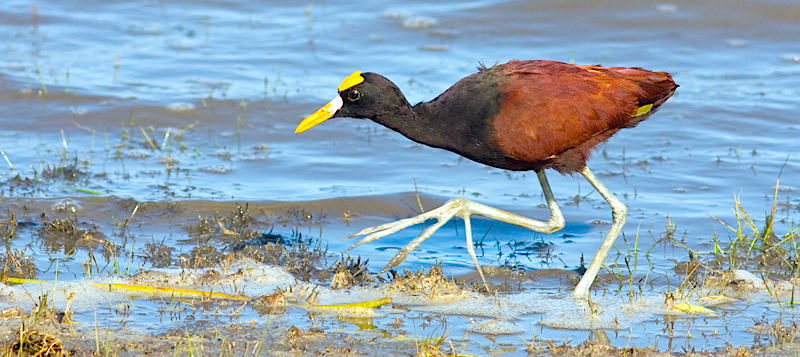
A Northern Jacana
shows off its long, slender toes as it picks its way
daintily along the shoreline at Crooked Tree. (Photo by tour
participants David & Susan Disher)
This was a special tour for me- old friends, a birdy tropical
destination, nice lodging, delicious food (pass me the Marie
Sharps), and cold beers (Belikin) in the evening-a winning
combination. It seemed we never stopped laughing and smiling.
Highlights included the "gun show" at Birds Eye View, a most
memorable boat ride down the Crooked Tree Lagoon with Jabirus
and nearly every conceivable long-legged wader (and those
wood-rails!), Agami Heron, and American Pygmy-Kingfisher(s),
the Johnny Jump Up performance, a spectacular Collared
Forest-Falcon flyby, an Orange-breasted Falcon taking a
Great-tailed Grackle in mid-air on his way to breakfast with
the family, Tom's impromptu assignment to captain of the USS
Belize, crossing the Belize River in record time, that
ice-cream stop in Mennonite country, and the experience that
had the greatest impact...Ruddy Crakes attacking Max's feet as
he went screaming and crashing into the lake. Not quite, but
Max spotted this pair, in the open, as they crept around
silently between the tall marsh grasses. And some odd and
unique vocalizations afterwards. What a great team!
Thanks so much for spending time with me in the field. Thanks
again to Michael (our local guide at Birds Eye) and the staff
of both Birds Eye and Black Rock. I look forward to seeing you
all again real soon (or on Facebook). ;-)
--Jesse Fagan aka Mot
For more information about this tour, including future
departures, visit our website at www.fieldguides.com.
And to see this same triplist online, go to http://www.fieldguides.com/triplists/bze12LIST.pdf
and you will find the list in its entirety.
KEYS FOR THIS LIST
One of the following keys may be shown in brackets for
individual species as appropriate: * = heard only, I =
introduced, E = endemic, N = nesting, a = austral migrant, b =
boreal migrant
Tinamidae (Tinamous)

The Gray-necked
Wood-Rails at Crooked Tree apparently don't realize that
rails are supposed to be shy and hard to see! (Photo by
tour participants Davis & Susan Disher)
GREAT TINAMOU (Tinamus major) [*]
Anatidae (Ducks, Geese, and Waterfowl)
BLACK-BELLIED WHISTLING-DUCK (Dendrocygna autumnalis)
MUSCOVY DUCK
(Cairina moschata)
BLUE-WINGED TEAL
(Anas discors)
Cracidae (Guans, Chachalacas, and
Curassows)
PLAIN CHACHALACA (Ortalis vetula)
Odontophoridae (New World Quail)
BLACK-THROATED BOBWHITE (Colinus nigrogularis)
Podicipedidae (Grebes)
PIED-BILLED GREBE (Podilymbus podiceps)
Ciconiidae (Storks)
JABIRU (Jabiru
mycteria)
WOOD STORK
(Mycteria americana)
Phalacrocoracidae (Cormorants and Shags)
NEOTROPIC CORMORANT (Phalacrocorax brasilianus)
Anhingidae (Anhingas)
ANHINGA (Anhinga
anhinga)
Ardeidae (Herons, Egrets, and Bitterns)
BARE-THROATED TIGER-HERON (Tigrisoma mexicanum)
GREAT BLUE HERON
(Ardea herodias)
GREAT EGRET
(Ardea alba)
SNOWY EGRET
(Egretta thula)
LITTLE BLUE HERON
(Egretta caerulea)
TRICOLORED HERON
(Egretta tricolor)
CATTLE EGRET
(Bubulcus ibis)
GREEN HERON
(Butorides virescens)
AGAMI HERON
(Agamia agami)
BLACK-CROWNED
NIGHT-HERON (Nycticorax
nycticorax)
YELLOW-CROWNED
NIGHT-HERON (Nyctanassa
violacea)
BOAT-BILLED HERON
(Cochlearius cochlearius)
Threskiornithidae (Ibises and Spoonbills)
WHITE IBIS (Eudocimus
albus)
GLOSSY IBIS
(Plegadis falcinellus)
ROSEATE SPOONBILL
(Platalea ajaja)
Cathartidae (New World Vultures)
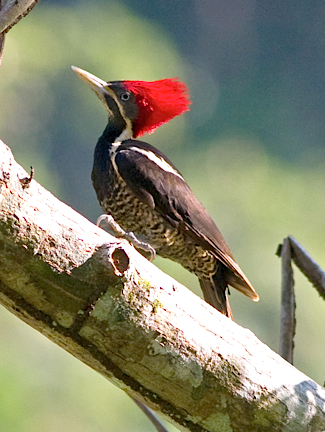
Lineated
Woodpeckers regularly feed on ants and termites, and that
may be what drew this one to this tree. Look carefully at
the underside of the branch: the dark line running up it
is a covered termite trail, though the cover is no match
for that bill! (Photo by tour participants Davis &
Susan Disher)
BLACK VULTURE (Coragyps atratus)
TURKEY VULTURE
(Cathartes aura)
LESSER
YELLOW-HEADED VULTURE (Cathartes
burrovianus)
KING VULTURE
(Sarcoramphus papa)
Pandionidae (Osprey)
OSPREY (Pandion
haliaetus)
Accipitridae (Hawks, Eagles, and Kites)
SWALLOW-TAILED KITE (Elanoides forficatus)
WHITE-TAILED KITE
(Elanus leucurus)
SNAIL KITE
(Rostrhamus sociabilis)
PLUMBEOUS KITE
(Ictinia plumbea)
BLACK-COLLARED
HAWK (Busarellus nigricollis)
CRANE HAWK
(Geranospiza caerulescens)
WHITE HAWK
(Leucopternis albicollis)
GREAT BLACK-HAWK
(Buteogallus urubitinga)
SOLITARY EAGLE
(Harpyhaliaetus solitarius)
ROADSIDE HAWK
(Buteo magnirostris)
GRAY HAWK (Buteo nitidus)
SHORT-TAILED HAWK
(Buteo brachyurus)
Falconidae (Falcons and Caracaras)
COLLARED FOREST-FALCON (Micrastur semitorquatus)
LAUGHING FALCON
(Herpetotheres cachinnans)
BAT FALCON
(Falco rufigularis)
ORANGE-BREASTED
FALCON (Falco deiroleucus)
Rallidae (Rails, Gallinules, and Coots)
RUDDY CRAKE (Laterallus ruber)
GRAY-NECKED
WOOD-RAIL (Aramides cajanea)
PURPLE GALLINULE
(Porphyrio martinica)
AMERICAN COOT
(Fulica americana)
Heliornithidae (Finfoots)
SUNGREBE (Heliornis
fulica)
Aramidae (Limpkin)
LIMPKIN (Aramus
guarauna)
Charadriidae (Plovers and Lapwings)
SEMIPALMATED PLOVER (Charadrius semipalmatus)
Recurvirostridae (Stilts and Avocets)
BLACK-NECKED STILT (Himantopus mexicanus)
Jacanidae (Jacanas)
NORTHERN JACANA (Jacana spinosa)
Scolopacidae (Sandpipers and Allies)
SPOTTED SANDPIPER (Actitis macularius)
SOLITARY SANDPIPER
(Tringa solitaria)
GREATER YELLOWLEGS
(Tringa melanoleuca)
LESSER YELLOWLEGS
(Tringa flavipes)
SEMIPALMATED
SANDPIPER (Calidris pusilla)
LEAST SANDPIPER
(Calidris minutilla)
PECTORAL SANDPIPER
(Calidris melanotos)
LONG-BILLED
DOWITCHER (Limnodromus
scolopaceus)
Laridae (Gulls, Terns, and Skimmers)
GULL-BILLED TERN (Gelochelidon nilotica)
CASPIAN TERN
(Hydroprogne caspia)
Columbidae (Pigeons and Doves)
ROCK PIGEON (Columba livia)
PALE-VENTED PIGEON
(Patagioenas cayennensis)
RED-BILLED PIGEON
(Patagioenas flavirostris)
SHORT-BILLED
PIGEON (Patagioenas
nigrirostris) [*]
PLAIN-BREASTED
GROUND-DOVE (Columbina minuta)
RUDDY GROUND-DOVE
(Columbina talpacoti)
BLUE GROUND-DOVE
(Claravis pretiosa)
WHITE-TIPPED DOVE
(Leptotila verreauxi)
GRAY-HEADED DOVE
(Leptotila plumbeiceps) [*]
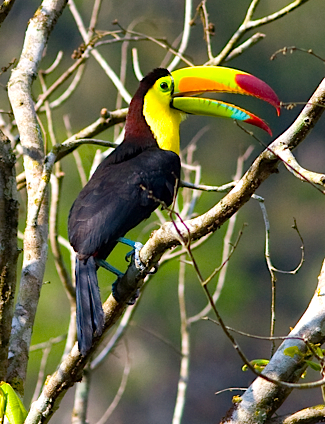
As if the
Keel-billed Toucan's rainbow bill isn't colorful enough,
check out its maroon nape, green eye liner, and bright
blue legs! Some birds just have it all. (Photo by tour
participants Davis & Susan Disher)
GRAY-CHESTED DOVE (Leptotila cassini) [*]
Psittacidae (Parrots)
OLIVE-THROATED PARAKEET (AZTEC) (Aratinga nana astec)
WHITE-CROWNED
PARROT (Pionus senilis)
WHITE-FRONTED
PARROT (Amazona albifrons)
RED-LORED PARROT
(Amazona autumnalis)
YELLOW-HEADED
PARROT (Amazona oratrix)
Cuculidae (Cuckoos)
SQUIRREL CUCKOO (Piaya cayana)
STRIPED CUCKOO
(Tapera naevia) [*]
PHEASANT CUCKOO
(Dromococcyx phasianellus) [*]
GROOVE-BILLED ANI
(Crotophaga sulcirostris)
Strigidae (Owls)
FERRUGINOUS PYGMY-OWL (Glaucidium brasilianum)
MOTTLED OWL
(Ciccaba virgata) [*]
Caprimulgidae (Nightjars and Allies)
COMMON PAURAQUE (Nyctidromus albicollis)
Apodidae (Swifts)
WHITE-COLLARED SWIFT (Streptoprocne zonaris) [*]
VAUX'S SWIFT
(RICHMOND'S) (Chaetura vauxi
richmondi)
LESSER
SWALLOW-TAILED SWIFT (Panyptila
cayennensis)
Trochilidae (Hummingbirds)
WHITE-NECKED JACOBIN (Florisuga mellivora)
PURPLE-CROWNED
FAIRY (Heliothryx barroti)
GREEN-BREASTED
MANGO (Anthracothorax
prevostii)
RUBY-THROATED
HUMMINGBIRD (Archilochus
colubris)
CANIVET'S EMERALD
(Chlorostilbon canivetii)
WEDGE-TAILED
SABREWING (Campylopterus
curvipennis)
WHITE-BELLIED
EMERALD (Amazilia candida)
AZURE-CROWNED
HUMMINGBIRD (Amazilia
cyanocephala)
RUFOUS-TAILED
HUMMINGBIRD (Amazilia tzacatl)
Trogonidae (Trogons)
SLATY-TAILED TROGON (Trogon massena)
BLACK-HEADED
TROGON (Trogon melanocephalus)
GARTERED TROGON
(Trogon caligatus)
Momotidae (Motmots)
BLUE-CROWNED MOTMOT (LESSON'S) (Momotus coeruliceps exiguus)
Alcedinidae (Kingfishers)
RINGED KINGFISHER (Megaceryle torquata)
BELTED KINGFISHER
(Megaceryle alcyon)
AMAZON KINGFISHER
(Chloroceryle amazona)
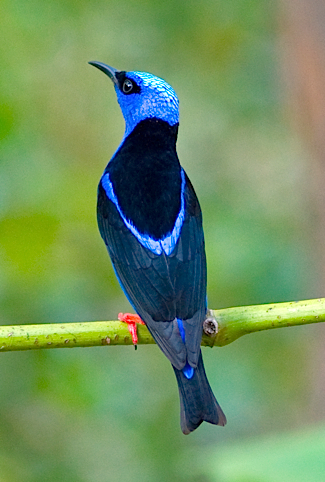
Another bird with
more than its share of brilliant color: a male Red-legged
Honeycreeper. (Photo by tour participants David &
Susan Disher)
GREEN KINGFISHER (Chloroceryle americana)
AMERICAN PYGMY
KINGFISHER (Chloroceryle
aenea)
Bucconidae (Puffbirds)
WHITE-WHISKERED PUFFBIRD (Malacoptila panamensis)
Ramphastidae (Toucans)
EMERALD TOUCANET (EMERALD) (Aulacorhynchus prasinus virescens)
COLLARED ARACARI
(Pteroglossus torquatus)
KEEL-BILLED TOUCAN
(Ramphastos sulfuratus)
Picidae (Woodpeckers)
ACORN WOODPECKER (Melanerpes formicivorus)
BLACK-CHEEKED
WOODPECKER (Melanerpes
pucherani)
YUCATAN WOODPECKER
(Melanerpes pygmaeus)
GOLDEN-FRONTED
WOODPECKER (EAST MEXICO) (Melanerpes
aurifrons dubius)
CHESTNUT-COLORED
WOODPECKER (Celeus castaneus)
LINEATED
WOODPECKER (Dryocopus
lineatus)
PALE-BILLED
WOODPECKER (Campephilus
guatemalensis)
Furnariidae (Ovenbirds and Woodcreepers)
PLAIN XENOPS (Xenops minutus)
OLIVACEOUS
WOODCREEPER (Sittasomus
griseicapillus)
IVORY-BILLED
WOODCREEPER (Xiphorhynchus
flavigaster)
STREAK-HEADED
WOODCREEPER (Lepidocolaptes
souleyetii)
Thamnophilidae (Typical Antbirds)
BARRED ANTSHRIKE (Thamnophilus doliatus)
Formicariidae (Antthrushes)
BLACK-FACED ANTTHRUSH (MEXICAN) (Formicarius analis moniliger)
Tyrannidae (Tyrant Flycatchers)
YELLOW-BELLIED TYRANNULET (Ornithion semiflavum)
NORTHERN
BEARDLESS-TYRANNULET (Camptostoma
imberbe) [*]
GREENISH ELAENIA
(Myiopagis viridicata)
YELLOW-BELLIED
ELAENIA (Elaenia flavogaster)
OCHRE-BELLIED
FLYCATCHER (Mionectes
oleagineus)
SEPIA-CAPPED
FLYCATCHER (Leptopogon
amaurocephalus)
NORTHERN BENTBILL
(Oncostoma cinereigulare) [*]
SLATE-HEADED
TODY-FLYCATCHER (Poecilotriccus
sylvia)
COMMON
TODY-FLYCATCHER (Todirostrum
cinereum)
EYE-RINGED
FLATBILL (Rhynchocyclus
brevirostris)
YELLOW-OLIVE
FLYCATCHER (Tolmomyias
sulphurescens)
ROYAL FLYCATCHER
(NORTHERN) (Onychorhynchus
coronatus mexicanus)
SULPHUR-RUMPED
FLYCATCHER (Myiobius
sulphureipygius sulphureipygius)
TROPICAL PEWEE
(Contopus cinereus)
YELLOW-BELLIED
FLYCATCHER (Empidonax
flaviventris)
LEAST FLYCATCHER
(Empidonax minimus)
BLACK PHOEBE
(Sayornis nigricans)
VERMILION
FLYCATCHER (Pyrocephalus
rubinus)
BRIGHT-RUMPED
ATTILA (Attila spadiceus)
YUCATAN FLYCATCHER
(Myiarchus yucatanensis)
DUSKY-CAPPED
FLYCATCHER (Myiarchus
tuberculifer)
GREAT CRESTED
FLYCATCHER (Myiarchus
crinitus) [*]
BROWN-CRESTED
FLYCATCHER (Myiarchus
tyrannulus)
GREAT KISKADEE
(Pitangus sulphuratus)
BOAT-BILLED
FLYCATCHER (Megarynchus
pitangua)
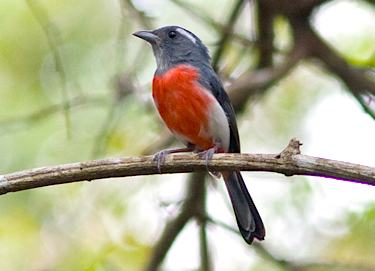
Long considered
members of the warbler family, the three species of
Granatellus chats are now thought to be more closely
related to the cardinals and grosbeaks and are now
included in the Cardinalidae. This is the Yucutan endemic
Gray-throated Chat. (Photo by tour participants Davis
& Susan Disher)
SOCIAL FLYCATCHER (Myiozetetes similis)
STREAKED
FLYCATCHER (Myiodynastes
maculatus)
SULPHUR-BELLIED
FLYCATCHER (Myiodynastes
luteiventris)
PIRATIC FLYCATCHER
(Legatus leucophaius)
TROPICAL KINGBIRD
(Tyrannus melancholicus)
COUCH'S KINGBIRD
(Tyrannus couchii)
EASTERN KINGBIRD
(Tyrannus tyrannus)
FORK-TAILED
FLYCATCHER (Tyrannus savana)
Pipridae (Manakins)
WHITE-COLLARED MANAKIN (Manacus candei)
RED-CAPPED MANAKIN
(Pipra mentalis) [*]
Tityridae (Tityras and Allies)
MASKED TITYRA (Tityra semifasciata)
THRUSH-LIKE
SCHIFFORNIS (Schiffornis
turdina) [*]
ROSE-THROATED
BECARD (Pachyramphus aglaiae)
Vireonidae (Vireos)
WHITE-EYED VIREO (Vireo griseus)
MANGROVE VIREO
(Vireo pallens)
PLUMBEOUS VIREO
(Vireo plumbeus)
RED-EYED VIREO
(Vireo olivaceus)
YELLOW-GREEN VIREO
(Vireo flavoviridis)
TAWNY-CROWNED
GREENLET (Hylophilus
ochraceiceps)
LESSER GREENLET
(Hylophilus decurtatus)
RUFOUS-BROWED
PEPPERSHRIKE (Cyclarhis
gujanensis) [*]
Corvidae (Crows, Jays, and Magpies)
BROWN JAY (Psilorhinus
morio)
GREEN JAY (Cyanocorax yncas)
YUCATAN JAY
(Cyanocorax yucatanicus)
Hirundinidae (Swallows)
NORTHERN ROUGH-WINGED SWALLOW (Stelgidopteryx serripennis)
PURPLE MARTIN
(Progne subis)
GRAY-BREASTED
MARTIN (Progne chalybea)
MANGROVE SWALLOW
(Tachycineta albilinea)
BARN SWALLOW
(Hirundo rustica)
Troglodytidae (Wrens)
SPOT-BREASTED WREN (Pheugopedius maculipectus)
CAROLINA WREN
(WHITE-BROWED) (Thryothorus
ludovicianus albinucha)
HOUSE WREN
(SOUTHERN) (Troglodytes aedon
musculus)
WHITE-BELLIED WREN
(Uropsila leucogastra)
WHITE-BREASTED
WOOD-WREN (Henicorhina
leucosticta)
Polioptilidae (Gnatcatchers)
LONG-BILLED GNATWREN (Ramphocaenus melanurus)
BLUE-GRAY
GNATCATCHER (Polioptila
caerulea)
TROPICAL
GNATCATCHER (Polioptila
plumbea)
Turdidae (Thrushes and Allies)
CLAY-COLORED THRUSH (Turdus grayi)
Mimidae (Mockingbirds and Thrashers)
GRAY CATBIRD (Dumetella carolinensis)
TROPICAL
MOCKINGBIRD (Mimus gilvus)
Parulidae (New World Warblers)
NORTHERN WATERTHRUSH (Parkesia noveboracensis)
BLUE-WINGED
WARBLER (Vermivora cyanoptera)
GOLDEN-WINGED
WARBLER (Vermivora
chrysoptera)
BLACK-AND-WHITE
WARBLER (Mniotilta varia)
PROTHONOTARY
WARBLER (Protonotaria citrea)
TENNESSEE WARBLER
(Oreothlypis peregrina)
GRAY-CROWNED
YELLOWTHROAT (Geothlypis
poliocephala)
KENTUCKY WARBLER
(Geothlypis formosa)
COMMON
YELLOWTHROAT (Geothlypis
trichas)
AMERICAN REDSTART
(Setophaga ruticilla)
MAGNOLIA WARBLER
(Setophaga magnolia)
BLACKBURNIAN
WARBLER (Setophaga fusca)
YELLOW WARBLER
(Setophaga petechia)
CHESTNUT-SIDED
WARBLER (Setophaga
pensylvanica)

A close relative
of the familiar Palm and Blue-gray tanagers, the lovely
Yellow-winged Tanager has a much smaller range than its
widespread cousins, being found only in northern Central
America and southern Mexico. (Photo by tour participants
Davis & Susan Disher)
GRACE'S WARBLER (Setophaga graciae)
BLACK-THROATED
GREEN WARBLER (Setophaga
virens)
RUFOUS-CAPPED
WARBLER (Basileuterus
rufifrons)
Thraupidae (Tanagers and Allies)
CRIMSON-COLLARED TANAGER (Ramphocelus sanguinolentus)
BLUE-GRAY TANAGER
(Thraupis episcopus)
YELLOW-WINGED
TANAGER (Thraupis abbas)
RED-LEGGED
HONEYCREEPER (Cyanerpes
cyaneus)
GRAYISH SALTATOR
(Saltator coerulescens)
BUFF-THROATED
SALTATOR (Saltator maximus)
BLACK-HEADED
SALTATOR (Saltator atriceps)
Emberizidae (Buntings, Sparrows and
Allies)
BLUE-BLACK GRASSQUIT (Volatinia jacarina)
WHITE-COLLARED
SEEDEATER (WHITE-COLLARED) (Sporophila
torqueola morelleti)
YELLOW-FACED
GRASSQUIT (Tiaris olivaceus)
GREEN-BACKED
SPARROW (Arremonops
chloronotus)
RUSTY SPARROW
(Aimophila rufescens)
CHIPPING SPARROW
(Spizella passerina)
Cardinalidae (Cardinals and Allies)
HEPATIC TANAGER (Piranga flava)
SUMMER TANAGER
(Piranga rubra)
SCARLET TANAGER
(Piranga olivacea)
RED-CROWNED
ANT-TANAGER (Habia rubica)
RED-THROATED
ANT-TANAGER (Habia fuscicauda)
BLACK-FACED
GROSBEAK (Caryothraustes
poliogaster)
NORTHERN CARDINAL
(Cardinalis cardinalis)
ROSE-BREASTED
GROSBEAK (Pheucticus
ludovicianus)
GRAY-THROATED CHAT
(Granatellus sallaei)
BLUE-BLACK
GROSBEAK (Cyanocompsa
cyanoides)
BLUE BUNTING
(Cyanocompsa parellina)
BLUE GROSBEAK
(Passerina caerulea)
INDIGO BUNTING
(Passerina cyanea)
Icteridae (Troupials and Allies)
RED-WINGED BLACKBIRD (Agelaius phoeniceus)
EASTERN MEADOWLARK
(Sturnella magna)
MELODIOUS
BLACKBIRD (Dives dives)
GREAT-TAILED
GRACKLE (Quiscalus mexicanus)
BRONZED COWBIRD
(Molothrus aeneus)
GIANT COWBIRD
(Molothrus oryzivorus)
BLACK-COWLED
ORIOLE (Icterus prosthemelas)
ORCHARD ORIOLE
(Icterus spurius)
HOODED ORIOLE
(Icterus cucullatus)
YELLOW-TAILED
ORIOLE (Icterus mesomelas)
BALTIMORE ORIOLE
(Icterus galbula)
YELLOW-BILLED
CACIQUE (Amblycercus
holosericeus)
MONTEZUMA
OROPENDOLA (Psarocolius
montezuma)
Fringillidae (Siskins, Crossbills, and
Allies)
SCRUB EUPHONIA (Euphonia affinis)
YELLOW-THROATED
EUPHONIA (Euphonia
hirundinacea)
OLIVE-BACKED
EUPHONIA (Euphonia gouldi)
YUCATAN SQUIRREL
(Sciurus yucatanensis)
GRAY FOX (Urocyon cinereoargenteus)
Totals for the tour: 250 bird taxa and 2 mammal taxa







